
OnePlus finally delivered its most powerful punch with the OnePlus 7 Pro, doing justice to its “Never Settle” motto. This OnePlus flagship was one of the best smartphones to be released in the first half of 2019, and continues to be used as a benchmark in comparing the performance of several newer releases. OnePlus also launched the OnePlus 7 alongside the Pro variant, a phone that delivered similar performance in a reliable package and a cheaper price tag, but without some of the fancier bells-and-whistles. Now, OnePlus is bringing back those bells-and-whistles with the launch of the OnePlus 7T: the newest SoC, a higher refresh rate display, faster charging, updated vibration motor, and a new triple rear camera setup housed within a unique circular camera module.
The OnePlus 7T still counts as an incremental upgrade over the OnePlus 7, but it marks itself as a big jump for markets like the USA that had to stay settled with the OnePlus 6T. But how good exactly is the new OnePlus 7T? Come along as we explore the good and the bad of this device in our review.
OnePlus 7T Specifications and Network Information
OnePlus 7T: Specifications
| Category | Specification | Category | Specification |
|---|---|---|---|
| Dimensions & Weight |
|
RAM | 8GB LPDDR4X |
| Design & Colors |
|
Storage | 128GB/256GB UFS 3.0 Dual-Lane |
| Display |
|
Battery | 3,800 mAh (non-removable) |
| Camera (Image) |
|
Charging | OnePlus WarpCharge 30T Fast Charging (5V 6A) |
| Camera (Video) |
|
Ports |
|
| Software | OxygenOS 10 based on Android 10 | Audio |
|
| System-on-chip | Qualcomm Snapdragon 855 Plus CPU:
Adreno 640 GPU |
Multimedia Codec Support |
|
OnePlus 7T Connectivity
| Category | Specification |
|---|---|
| Connectivity |
|
| LTE Features |
|
| LTE Bands – CN/IN |
|
| LTE Bands – NA |
|
| LTE Bands – EU |
|
Hardware Design & Build Quality
While OnePlus has been offering solid smartphone hardware for many years now, it arguably wasn’t until the OnePlus 6 and 6T that they truly tried taking on the premium flagship market head-on, adopting not just their innards but their looks too. The OnePlus 7 Pro was the company’s first foray into the ultra-premium smartphone segment, a tier in specs and price above any of its previous offerings, and said phone managed to successfully look the part. Its glass sandwich design was heftier and extremely solid, with dazzling, light-catching patterns on the back of the device not unlike what we see in more expensive phones. The OnePlus 7T, however, aims to up the ante in what OnePlus calls “the culmination of all [their] design and engineering efforts”. So what’s different?
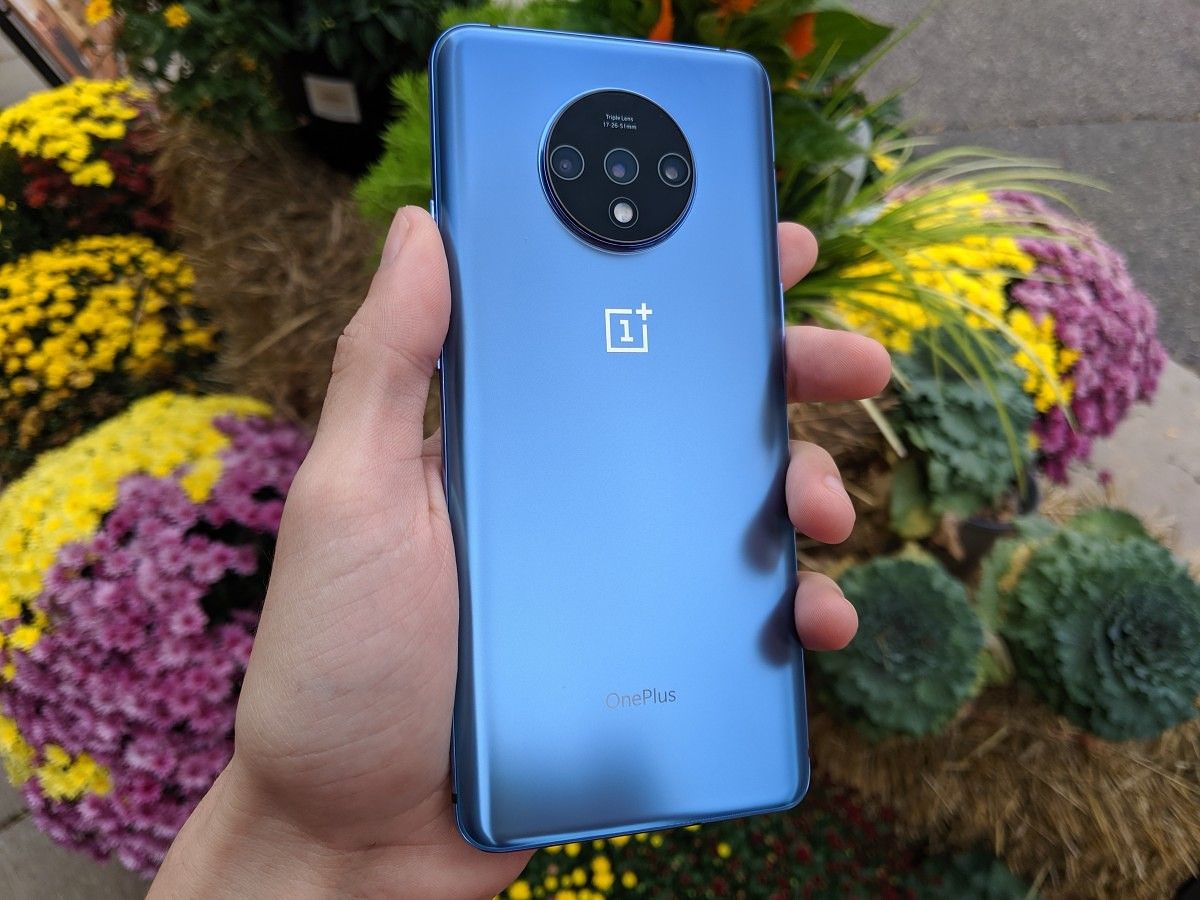
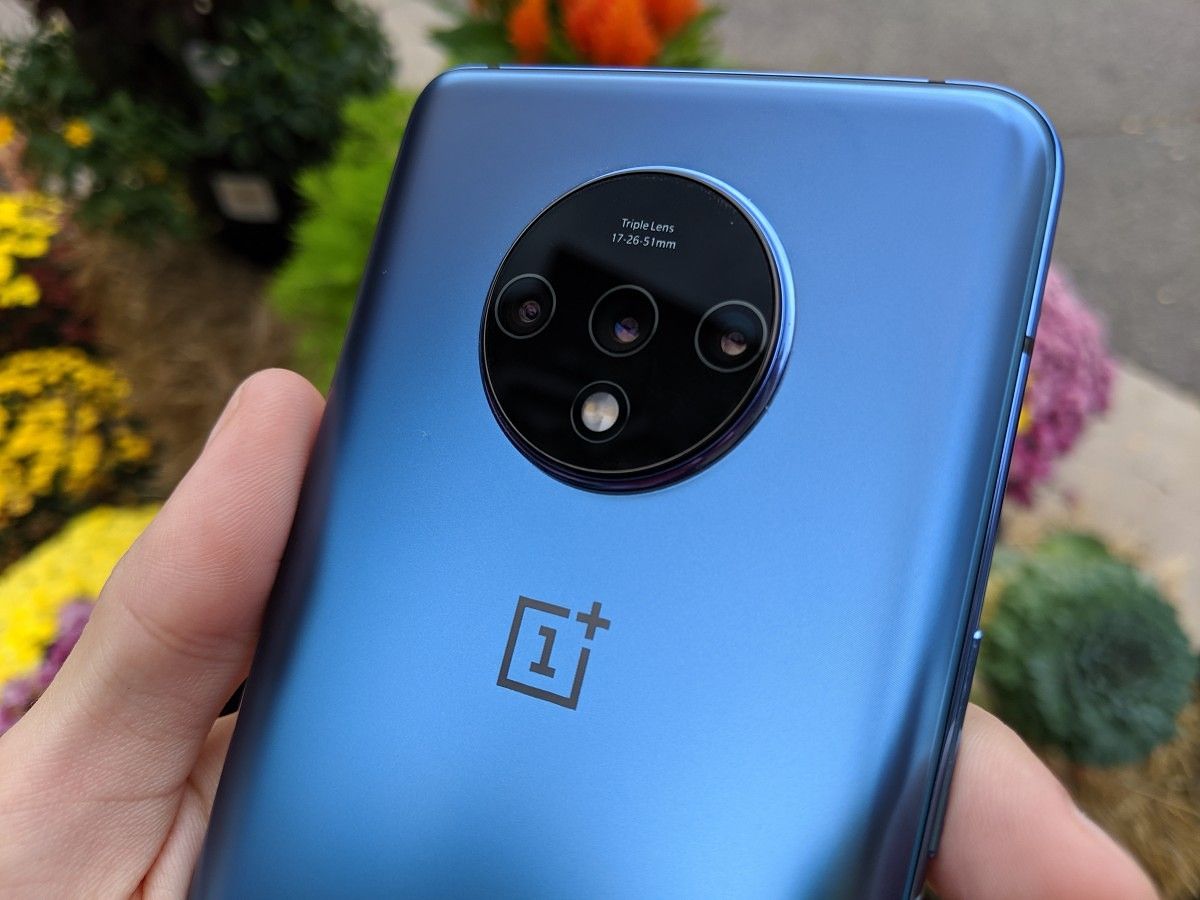
| OnePlus 7T | OnePlus 6T | OnePlus 7 | OnePlus 7 Pro | |
| Height (mm) | 160.95 | 157.5 | 157.7 | 162.6 |
| Width (mm) | 74.44 | 74.8 | 74.8 | 75.9 |
| Thickness (mm) | 8.13 | 8.2 | 8.2 | 8.8 |
| Weight (g) | 190 | 185 | 182 | 206 |
In terms of dimensions, the OnePlus 7T obviously takes after the OnePlus 7 and not the Pro. The OnePlus 7T is ultimately a bit longer than the regular OnePlus 7, in part because it has a 6.55-inch flat screen with a taller 20:9 aspect ratio, compared to its predecessors 6.41-inch, 19.5:9 display. This taller aspect ratio over the OnePlus 7 and 7 Pro is actually one of the first things I noticed, as it gives the device a candy-bar profile that also slightly alters handling, though not for the worse. The phone is also slightly narrower, thinner, and weighing just 190 grams, this phone is lighter than the OnePlus 7 Pro (206 grams) but not the regular OnePlus 7 (183 grams) or the OnePlus 6T (185 grams). Ultimately, though, the thinner and narrower profile makes the phone feel a tiny bit more compact in the hand, and this is further reinforced by the way in which the back is shaped.


The back glass cover of the phone comes in two color variants, Frosted Silver and Glacier Blue, both coated with Gorilla Glass 5 for shock and scratch protection. If you only look at renders, you might guess that the latter looks very similar to the OnePlus 7 Pro’s Nebula Blue color, but it is decidedly different in person. The OnePlus 7T features a light-sky blue that contrasts the 7 Pro’s much deeper and darker hue; both devices also reflect light very differently, with the OnePlus 7T offering less of an inner gradient and more of a mirror finish.
The Glacier Blue variant makes other blue glass back flagships look frivolous and almost tacky by comparison.
The result is very attractive, given that the ways in which it catches light are able to showcase all the tiny and subtle curves around the edges of the phone. There is no shortage of reflective blue back designs in the flagship smartphone world, offering all sorts of gradients and light patterns; this is the fourth device I’ve tested with such a blue back in the past year and I think it might be my favorite. It is a lot subtler and more restrained, making other such back designs look frivolous and almost tacky.
While there are small changes to the phone’s dimensions and backplate design, it largely handles and looks the same as the regular OnePlus 7. The one change that’s both immediately and radically different, though, is the new triple-camera array, housed in a large black circle in an approach similar to that of other flagship devices released or announced in the past year. The cameras are ever-so-slightly closer together this time, and while OnePlus claims that the arrangement of the phone’s inner components was largely responsible for this new camera placement, it’s also unmistakably a significant aesthetic design decision. And to be honest, while I found it really odd, unappealing and even arbitrary at first, it has started to grow on me. The circle ultimately works well in concert with the new color, and while it protrudes significantly, it doesn’t impair usage — unlike many other camera protrusions, particularly those that aren’t centered, this arrangement does not cause any wobbling on a table. The glass immediately covering the cameras is slightly recessed and given the device makes an angle with any surface, I wouldn’t expect the circle’s glass to get scratched. OnePlus’ official cases even make the circle more attractive (or bearable, in case you hate it) by essentially eliminating the protrusion altogether.
As for the front of the device, the phone still features a waterdrop notch, but this time it is 31.46% smaller than the one found on the OnePlus 6T. Of course, the 7 Pro did away with the notch altogether, but beyond that, the bezels of both devices are almost identical with both featuring essentially the same bottom bezel width. Having used the OnePlus 7 Pro as my daily driver for the past several months, returning to the waterdrop notch was a bit strange at first. But the notch debate has largely given out, if only because notches have proven to be almost inescapable across the flagship smartphone space.
This notch is particularly unobtrusive, and my brain learned to ignore it after just a few hours of usage; I never found the pop-up camera of the 7 Pro or other devices particularly inconvenient, though, and in the end, I do find such designs just slightly more attractive. There is just something special about watching content edge-to-edge on the OnePlus 7 Pro’s display, an illusion spoiled in this device by the tiny notch biting onto the side of your video. But the waterdrop notch, in particular, gives the front of the device an unmistakably “OnePlus” vibe that was entirely lost with the 7 Pro’s all-new front. Part of that is also due to this phone’s flat-screen — personally, I think the OnePlus 7 Pro’s curved display was a bit of a mistake, as the curves didn’t start close enough to the edges. The flat screen is much more practical in daily usage.
Finally, the build quality of my unit is excellent, with impressively clicky buttons that have no unwanted wobble to them (which, by the way, is the bane of my existence). The alert slider is also clicky, adopting the smaller format introduced in the OnePlus 7. I do worry about the device being too fragile, though, but I rather wait for the assessment of figures like Zach from JerryRigEverything before making any further claims on the matter. While the phone does not come with an IP rating, it is still reportedly resistant to water and dust ingress. However, the lack of IP certification means you essentially have to take OnePlus’ word for it, and water damage is not covered by the warranty
Software
We’ve written plenty about OxygenOS in the past, and I’ll tell you right now that the software of the OnePlus 7T lives up to our expectations. A perk of OnePlus phones is that, barring a few past exceptions, they’ve received excellent software support. But moving forward, OnePlus is offering even better update schedules, rivaling Google’s two-year major OS update and three-year security update guarantee. While the company has been relatively speedy with software updates for their flagships in the past, they have even begun rolling out the latest Android 10 update for the OnePlus 7 and 7 Pro already, though the staged rollout means many people waiting for their OTA might not see the new software by the time they read this review. If that’s the case, then this is a great opportunity to learn what’s new in OxygenOS 10, given that the OnePlus 7T packs the latest Android software out of the box, being one of the first Android 10 phones released thus far. In these next two sections, we’ll go over the core OxygenOS experience for the uninitiated, and detail the new changes for those already acquaintanced with OnePlus’ software.
User Interface and Customization
From the get-go, OxygenOS has offered a more toned-down user interface than what’s found on most other handsets. OnePlus has largely stuck close to the Stock Android formula that enthusiasts have always loved, but this isn’t to say that their software is bare-bones. Quite the contrary, as time has gone on we’ve seen them deviate further from Stock Android, introducing their own alterations and design language, quirks, accents and even their own OnePlus Slate font as an alternative to the tried-and-true Roboto. Android 10 brought even more changes to the user interface, and like every year, OxygenOS followed suit by bringing its own suite of UI refinements and customization enhancements. OnePlus users can expect these changes when they receive their OxygenOS 10 update.
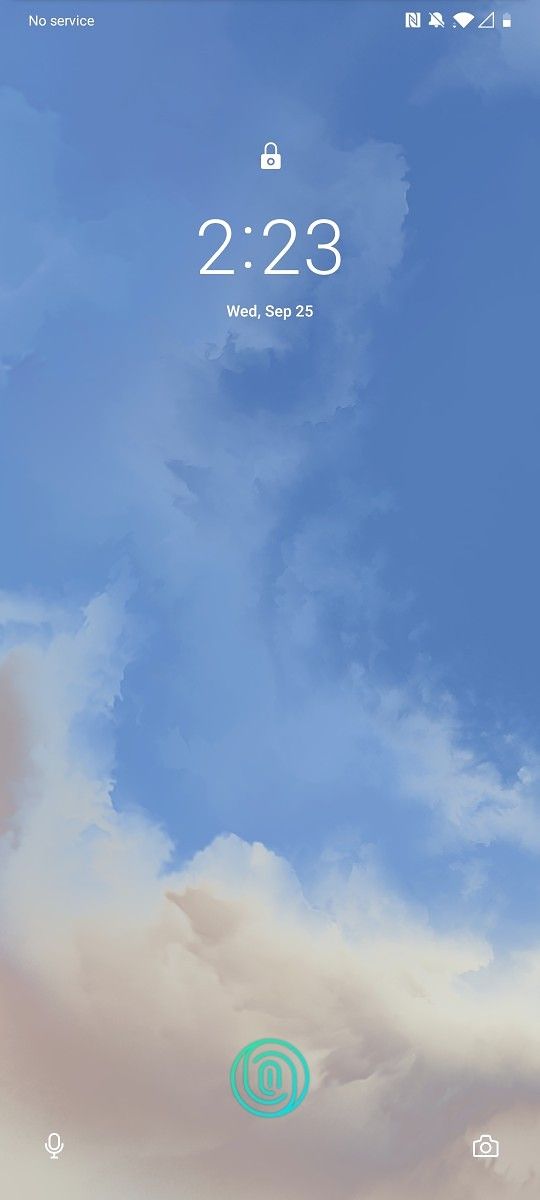

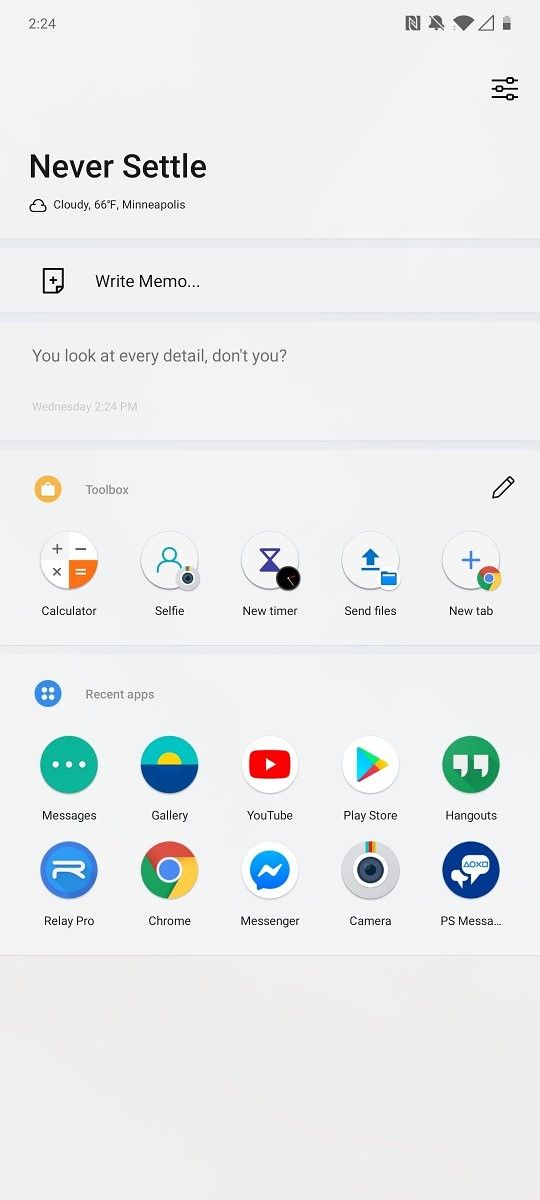
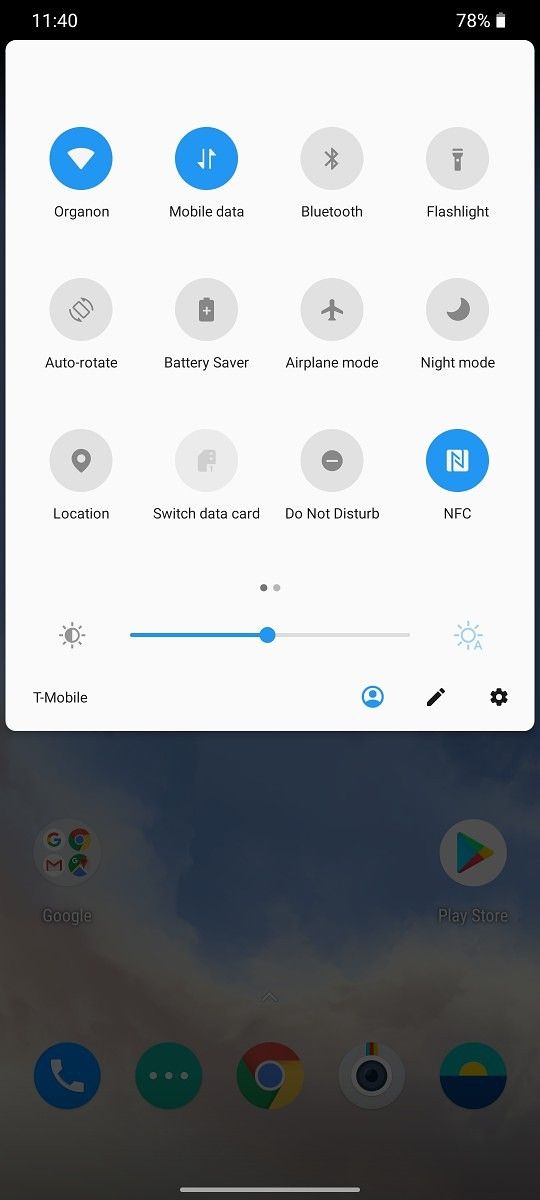

Let’s go through what’s new or different. While the lockscreen in Oxygen OS 10 is identical after the update, it now features a very subtle but much-needed transition whenever you unlock the phone using the fingerprint scanner. Before, it would do a jarring swap to the homescreen, whereas now the homescreen quickly fades in — this coupled with the OnePlus 7T’s excellent animated wallpapers makes unlocking the phone satisfying every time.
There are no real changes to the launcher, which stays relatively stock and simplistic. Swipe right on the homescreen to reveal the “Shelf”, where you can set apart specific apps, with a customizable toolbox for app and activity shortcuts, customizable memos, weather information, and now a recent app history for quick multi-tasking. A swipe up reveals the app drawer, with an app history at the top as well as the search bar. Then, swiping to the side within the app drawer reveals the “Hidden Space”, which enables you to keep applications off the main drawer, and also lets you set up a password to add another layer of privacy.
Everything else in the homescreen remains the same, and there are no significant changes in the rest of the UI. The notification drawer features the same toggles and styling, barring slight text changes, and the Recents menu is identical and essentially straight out of Stock Android. The ambient display has gotten better, though, as enabling “Smart Display” now lets you see media player and calendar information in the form of small notifications near the bottom of the screen.
There have been various changes to the settings menu, however, which got a slight makeover. It is now organized in subtle cards or sections, grouping up similar settings such as connectivity, security and privacy, and so on. This makes it slightly more intuitive, as it’s easy to visually delineate the clusters of relevant settings.


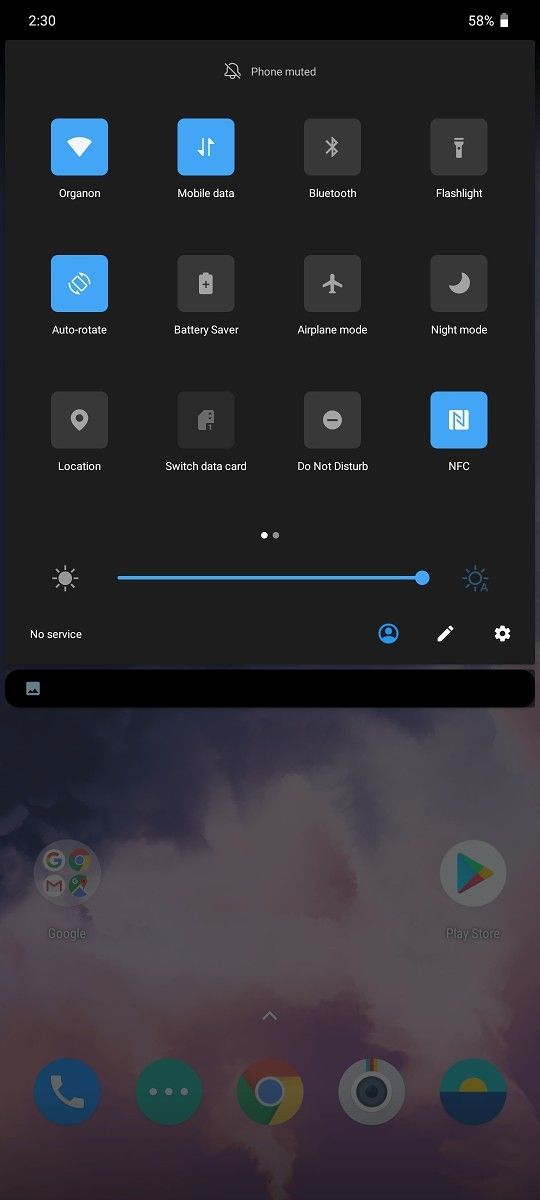
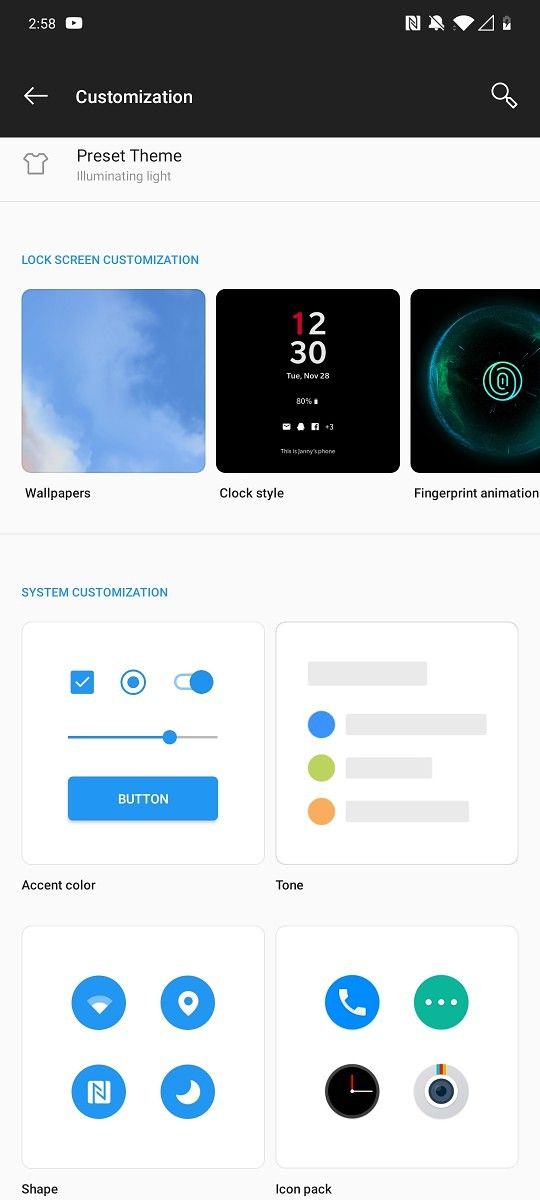
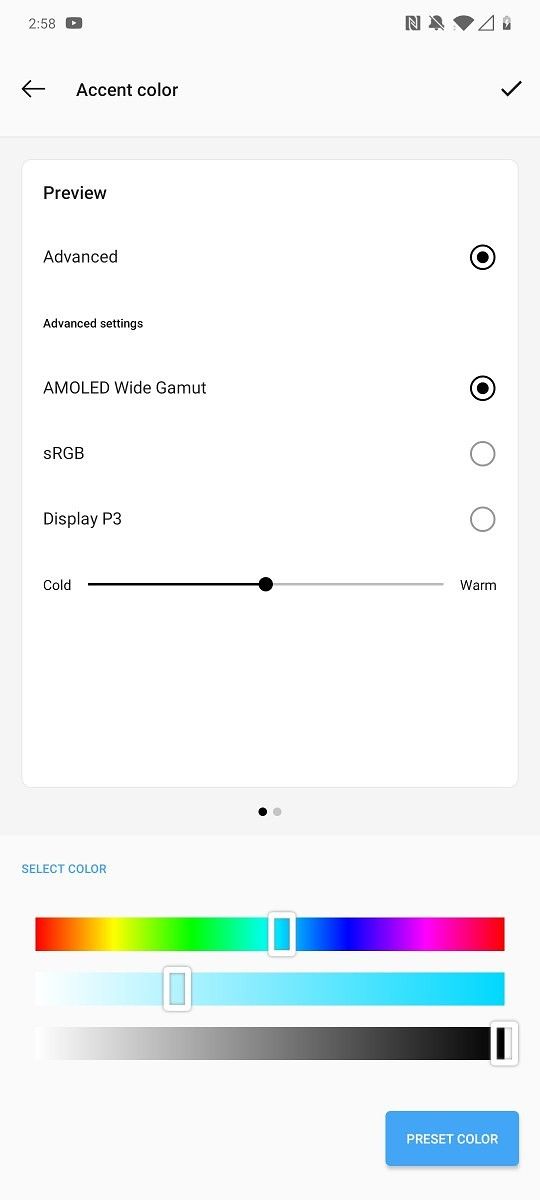
One of the better parts of Oxygen OS has always been how customizable its user interface is, and the customization menu has been revamped to offer a more visual and intuitive way of understanding each change. You can tweak the clock style of the ambient display, or the fingerprint unlocking animation (sadly, there are no new options, and the colors remain fixed and un-customizable). You can still customize accent colors, and you now get a preview of which elements get changed, and how they look under the new color. Instead of a color box based on the hue in the rainbow slider, however, OxygenOS 10 gives you two different sliders to finely pick the right color for your UI. You can also change the icon shape in the quick setting tiles, with new square, teardrop, and round rectangle options.
OxygenOS continuously manages to stand out by adding tasteful UI changes and customization
Of course, you can also turn on dark mode, which the company has been offering since its second device. This theme makes perfect use of the device’s AMOLED display to give you excellent contrast and also helps with battery life. The three different tones (light, dark, and colorful) apply changes to the menu, the notification drawer and quick toggles, the OxygenOS drawer and shelf, the Google search bar widget, as well as first-party apps like the phone’s default messaging app. Switching to dark mode also enables dark mode in third-party apps that rely on the system dark mode settings.
Those are the main notable aspects and changes of the user interface. OxygenOS still offers a fairly straightforward yet flexible user interface that looks clean and tidy. While other manufacturers have either improved their own offerings or adopted Stock Android alternatives, OnePlus’ custom “skin” manages to stand out by largely doing away with clutter, unnecessary changes, and only adding tasteful UI accents or features wherever it is actually beneficial.
Software Features and User Experience
In terms of software features, this T revision offers largely the same features as previous OxygenOS versions and everything that OnePlus users can expect when Android 10 arrives to their devices. Some of these improvements are specific to OnePlus-exclusive functionality, but users can also expect most of the improvements coming to Android 10 itself, which we’ve documented across several articles. One such feature is quick Wi-Fi sharing — from your Wi-Fi settings, you can select the network that you are connected to, then tap the “Share” button to generate a QR code that can be scanned by others attempting to swiftly join the network. You will also find access to Smart Reply in all messaging apps, the improved Sharing menu, overhauled permissions, and of course… gesture-based navigation.
OnePlus has been offering its own robust set of lockscreen gestures for years, which lets you draw certain shapes when the screen is off and map those actions to apps or specific shortcuts. Another great OxygenOS feature that I use daily is the ability to take screenshots with a three-finger swipe down the screen. However, OnePlus has also offered gesture-based navigation in OxygenOS as early as the OnePlus 5T, and those gestures actually worked quite well. Android 10, on the other hand, brings its own take on gestures… and so far, it seems not everyone is a fan. Luckily, though, OnePlus improves upon Google’s gestures by limiting the zone at which the “back” action is triggered. By default, on Stock Android, swiping from either side of the screen triggers the “back” action, which is problematic given that it interferes with activating side menus. On OxygenOS 10, however, the top portion of the screen doesn’t trigger the “back” gesture, allowing you to easily access side menus or swipe across tabs. Like with Android 10, you can swipe from the bottom corners to trigger Google Assistant, and OnePlus also lets you hide the navigation bar altogether in order to maximize screen real estate.





I would say that the gestures work fine on the OnePlus 7T, though I also miss OnePlus’ own navigation gestures. At the same time, though, these gestures are quite fluid and transitioning between apps by sliding across the bottom of the screen is not only quick but also extremely satisfying given the overall fluidity of the device and its 90Hz display. If you aren’t a fan of navigation gestures, you can also customize the traditional navigation bar by swapping the order of the recents and back buttons, and by mapping double tap and long-press actions to each key.
As for unlocking, we still have access to face unlock which remains one of the quickest (albeit not necessarily safest) solutions on the market. According to OnePlus, the under-display fingerprint scanner of the OnePlus 7T sees accuracy improvements over previous generations due to software tuning. I haven’t had any complaints with it, as it’s been fairly quick and extremely accurate for me. One of my favorite OxygenOS features is tied to fingerprint unlocking as well: after unlocking the device, you can keep holding the screen to bring up a customizable menu of app shortcuts. By continuing to hold the finger, you can scroll across the horizontal list, and releasing the finger launches the application. This is an excellent feature if, for example, you typically unlock your phone to look at a social media feed. Given you can initiate the gesture within your pocket, you are effectively able to have the specific app ready by the time you draw out your phone.
OxygenOS is littered with small, useful features like that. For example, they offer one of the best screenshot editors out there, allowing you to quickly crop, rotate and even blur portions of the screenshot. They were also one of the first ones to include expanded screenshots, which often come in handy. They also have a simple video editor that lets you quickly trim clips, add filters, and also add music from a small (and admittedly awful) selection of tunes. This last feature is particularly neat because of the excellent built-in screen recorder, which can be accessed from the quick toggles.
This brings a floating window that lets you start, pause and stop recording your screen, and a settings menu to configure the recording process. What’s great about this mode is that it even lets you change resolution and bit rate for smaller and easily-shareable clips, and choose whether you want to record microphone or internal audio. Now, you can even choose 24MBps bit rate (up from a maximum of 20) and lower the framerate from 60 to 30, 34 or 15 FPS. This screen recorder is perfect for gaming, in particular when you want to share a great flank replay with others.





Speaking of gaming, in recent months, the company has expanded its old Do Not Disturb Gaming mode into a fleshed-out service with its own app. “Game Space” acts as a hub for all of your games, not unlike the gaming center apps other manufacturers also offer. You can quickly launch your games by swiping cross their respective cards in a horizontal list, or a more traditional app icon approach. With Game Space, you can make it so that whenever you receive notifications while in a game, you only get a discreet text pop-up.
You can also turn call notifications from third-party apps into text pop-ups, make it so that calls are automatically answered via the speaker, and turn off auto-brightness for your games. Other options include haptic feedback enhancement, automatic network switching to avoid lag, and graphics optimization in the form of improved shadow details. Then there is Fnatic mode, which (1) blocks all notifications and calls (2) restricts background processes to maximize CPU and GPU allocation, and (3) stops the secondary SIM. Whenever you are inside a game, a persistent notification will allow you to access Game Space settings or turn on Fnatic mode directly with a button shortcut.





The opposite of Fnatic would be OnePlus’ Zen Mode. On top of offering Android’s typical Digital Well-being features, the OnePlus 7T offers Zen Mode to voluntarily lock yourself out of your phone, and focus on other things. It’s the same as what’s found on previous OnePlus devices, and now you can now choose not just a 20-minute lockout, but also 30, 40 and 60-minute sessions. I personally have no need for Zen Mode, though those who do enjoy the feature can also keep track of their total time in this mode, how many notifications were muted, and how many days it’s been used. You can also save these stats as screenshots, or share them directly from the app to let everyone know how much you are not using your new phone.
The alert slider remains one of the best perks exclusive to OnePlus
Beyond these note-worthy features, OxygenOS offers a plethora of extra functionality. By now, you probably already know about the alert slider that’s characteristic of every OnePlus device since the OnePlus 2, which of course makes a return and needs no explanation. It remains one of my favorite perks of the device, though, as it’s something I use multiple times a day, every day. By contrast, there are also features I personally hardly ever use, yet might come in handy to some of you. Parallel apps let you essentially log in with two different accounts on the same app, in supported services like Discord or FB Messenger; the App Locker lets you make it so that certain apps require authentication, and also lets you hide their notification content. Quick Reply in landscape lets you reply to an incoming notification by essentially opening a smaller version of the app to the side.
You get the idea. While I haven’t included features related to the display, camera, and battery life or charging in this section, this list makes it clear that the OnePlus 7T brings a ton of functionality. If you already have a OnePlus device, though, you can expect all of these features via software updates.
Camera
With the OnePlus 7T, the company is bringing its triple camera arrangement from the ultra-premium to the premium category, a move that will undoubtedly help it compete better against upcoming camera juggernauts like the Google Pixel 4. The OnePlus 7 Pro offered a versatile mix with its 48MP primary rear shooter, complemented by a telephoto and a wide-angle camera, and the OnePlus 7T mimics this approach with some slight changes. The primary camera here is comprised of the 48MP Sony IMX586 sensor with f/1.6 aperture and 1.6μm pixel size, as well as OIS and EIS — this is the same setup as the OnePlus 7 Pro. The front-facing camera is also the same Sony IMX471 16MP sensor with f/2.0 aperture and 1.0μm pixel size, capable of video recording up to 1080p at 30 frames per second. Both are extremely serviceable shooters, and this also means that the differences we found with the OnePlus 7 Pro are essentially due to different software, with our 7 Pro samples not coming out of OxygenOS 10.
The similarities carry on to the 117° wide-angle camera, a 16MP shooter with f/2.2 aperture, which is also slated to obtain 4K recording at 30 frames per second via an upcoming update. The telephoto camera, however, is different from the 7 Pro’s 8MP 3x lossless/2.2x optical zoom offering — instead, we get 2x optical zoom in a 12MP shooter with f/2.2 aperture, 1.0μm pixel size, and EIS. (Technically, though, it’s a 13MP sensor with its output cropped to 12MP for the one-to-one match.) Additions to the camera experience also include wide-angle portrait mode, and macro mode enabled by the auto-focus on the wide-angle lens, one of the release’s signature features that will not be making it to the OnePlus 7 Pro.




Besides the buttons for this new macro mode, as well as the new “Super Stable” mode in video recording (which also made its way to the OnePlus 7 Pro with OxygenOS 10’s camera), there are no changes in the camera UI, which remains serviceable. In the samples above, you can see that macro mode does indeed take some excellent close-up pictures, with sharp detail and decent focus on the tiny subjects at a distance of 2.5cm to 8cm.





Day-to-day pictures have also been fairly good with the OnePlus 7T, and as shown in the comparisons below, one can even spot a few clear differences with the 7 Pro’s outputs (before the OxygenOS 10 update). While we only compare the 7T against the Pixel 3 XL and OnePlus 7 Pro in this article’s samples, we will also be pitting it against other impressive cameras like the Galaxy S10 and Honor 20 Pro in our comprehensive review coming soon. I was originally quite disappointed with the camera experience provided by the OnePlus 7 Pro, which has time and time again ruined shots other phones would have an easy time with. That being said, some of the issues persist here, with images that often look a bit too soft and bright, simply not getting the exposure or highlights right at all.





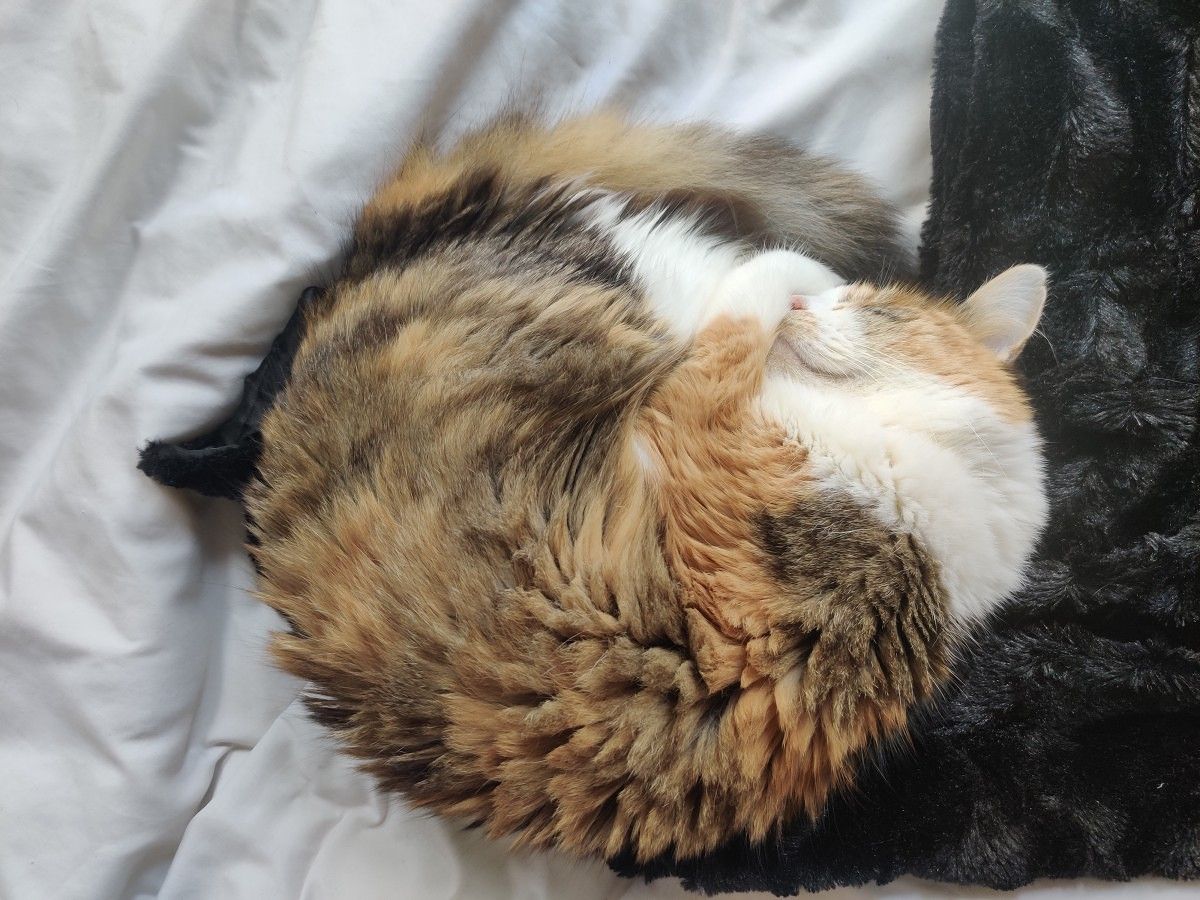


At the very least, though, the camera improvements are a testament to OnePlus’ continued refinements in this front, not just across devices but also across their frequent software updates. For example, Nightscape’s algorithm has been tweaked over time, improving slightly and enabling wide-angle support for the 7 Pro, which is also available on the 7T. Personally, I’ve been enjoying the wide-angle lens for this and other reasons, but the telephoto lens, which doesn’t support nightscape still, has just produced very inconsistent results and has been fairly disappointing overall.
I’ve also been content with portrait mode, which in my experience competes fairly well against the Pixel 3 XL’s, and outclasses the Galaxy S10+ and Honor 20 Pro. The front-facing camera is also fairly good, but again, we will be revisiting these assessments when we publish our full camera review.
Finally, the OnePlus 7T supports video recording with all three lenses, an improvement over the OnePlus 7 Pro that adds even more flexibility to the device. However, not all lenses can record videos in every mode, with the wide-angle lens currently missing 4K video. As for the main camera, we find the now-typical 4K 60/30FPS and 1080p 60/30FPS recording modes, but also slow-motion recording at 1080p and 240FPS as well as 720p and 480FPS. According to OnePlus, the device will be receiving 960FPS at 720p slow-motion video recording in an upcoming update. Below you can find a video sample comparing the 7 Pro and the 7T (with “Super Stable” mode on).
Display and Audio
The OnePlus 7T offers a 1080p AMOLED panel with a high refresh rate of 90Hz, meaning that OnePlus is now offering high refresh rate panels across its two different product tiers. This 6.55-inch panel features a resolution of 2400 by 1080 pixels, with a resulting aspect ratio of 20:9, a smidgen taller than the 19.5:9 aspect ratio of the 7 Pro and regular OnePlus 7. This is actually one of the things I noticed most when going back and forth between devices, and I would say the taller display ultimately helps the user experience (even if only slightly) by providing more vertical real estate for content feeds. With a pixel density of 402 ppi, this panel is simply not as sharp as the OnePlus 7 Pro with its 516 ppi, or other 1440p devices for that matter. That said, this display brings some advantages of its own over both the OnePlus 7 and even the OnePlus 7 Pro.
First things first, the 90Hz refresh rate is simply amazing, and after having gotten accustomed to it through daily driving the OnePlus 7 Pro, it is hard for me to go back to 60Hz panels. This is something that is simply impossible to convey through words or videos and is best felt in person. The advent of high refresh rate displays has essentially raised the bar for smartphone performance, allowing for much more fluid and smoother UI interactions. Of course, you can dial back to 60Hz in the interest of battery life, but keep in mind OnePlus is still variably adjusting the refresh rate by switching to 60Hz during phone calls, while watching videos or when using the camera app.
Media consumption on the OnePlus 7T is fantastic thanks to a rich panel and powerful stereo speakers
But what does this panel offer over the 7 Pro? OnePlus claims that this display is brighter than that of the OnePlus 7 Pro by well over double-digit percentage points, able to reach a brightness of up to 1,000 nits under direct sunlight. None of this is bad, especially considering that the OnePlus 7 Pro could only reach around 600 nits using auto-brightness. (By the way, I still find OnePlus’ auto-brightness to be one of the worst ones I’ve personally used; it never gets the brightness quite right for me, and it insists on sliding it back down immediately after I adjust it). Another change is that the device features new “internal luminescent material” that blocks 40% of blue light projection, reducing eye strain and earning it TÜV Rheinland’s “Eye Comfort” certification.
I can personally say that I somewhat notice the difference when compared to the OnePlus 7 Pro’s display, but on the whole, they both seem calibrated very similarly in terms of color reproduction. This isn’t a bad thing at all, given that we had plenty of good things to say about the OnePlus 7 Pro in our display analysis, and previous OnePlus displays as well. The phone’s display is also HDR10+ certified, so it is able to reproduce HDR video with wider color and better contrast.
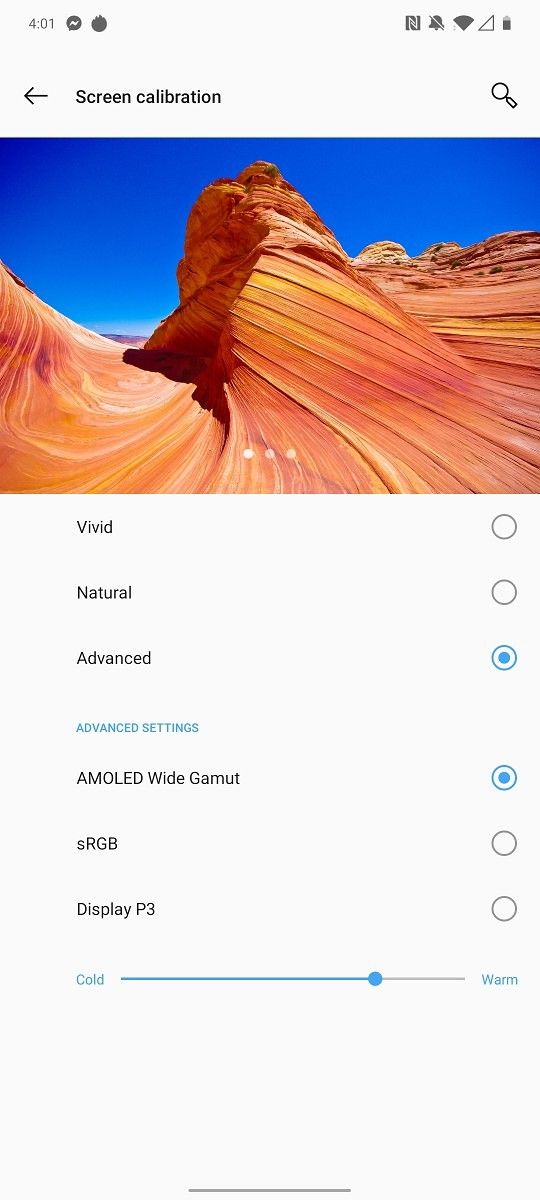
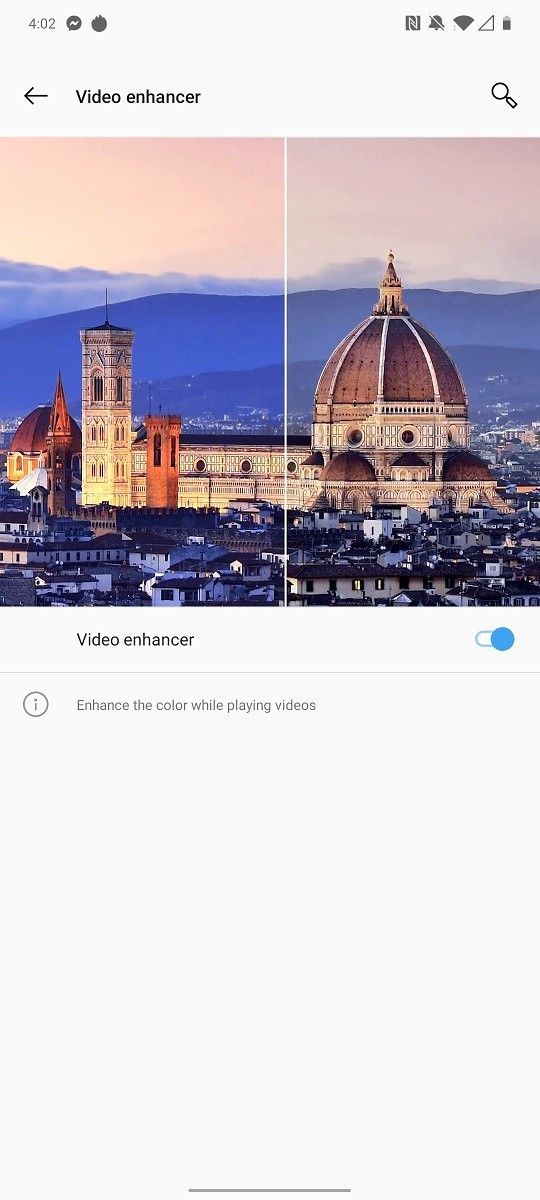
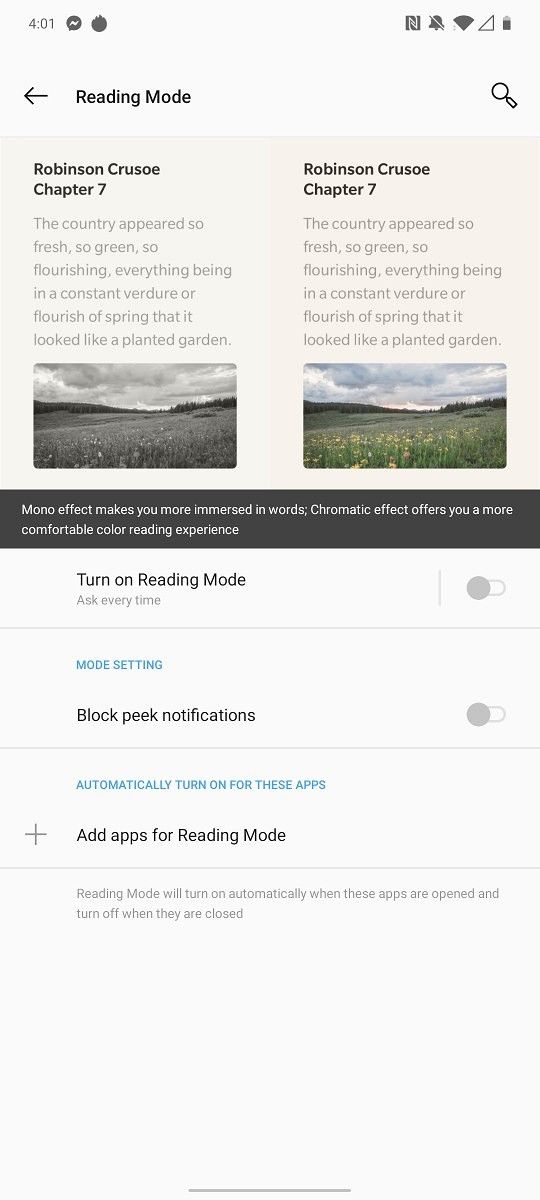
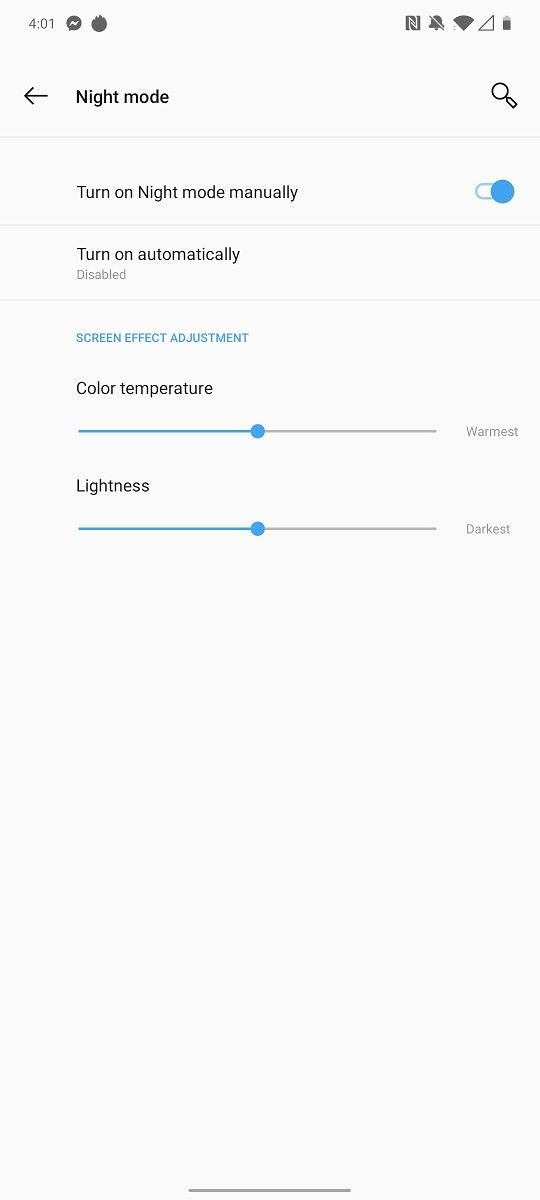
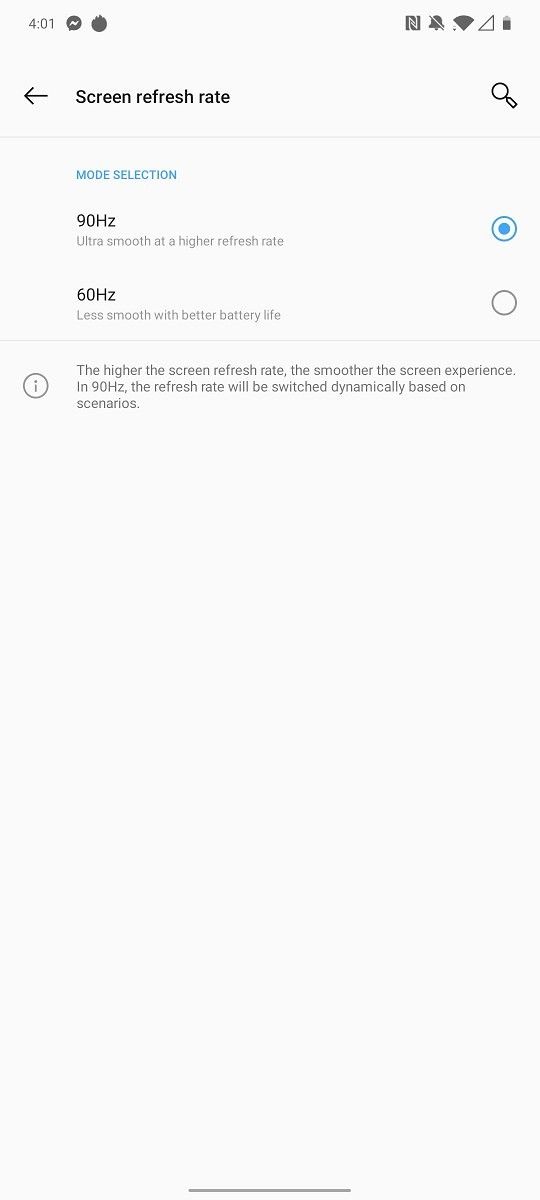
As in previous devices, you are able to choose between three display profiles: vivid (default), natural (closer to sRGB) and advanced, which further lets you select between AMOLED Wide Gamut, sRGB. Display P3, and tune the color temperature of the display.
As far as media consumption goes, the OnePlus 7T is fantastic. As you’ll see in the battery life section, I watched a lot of YouTube and Netflix on this device, and it’s been a joy to watch. There have definitely been times where I wasn’t able to visually resolve as much detail, however, thanks to that 1080p screen. But the bright, vivid display flanked by the excellent and loud dual stereo speakers, which are enhanced by Dolby Atmos, really stood up to my expectations, which were fairly high given the fact that I have been hopping from Samsung to OnePlus and back for my daily drivers.
Speaking of those speakers, they really do get quite loud and are rather clear, and definitely on par with those found on the OnePlus 7 Pro. There is no 3.5mm headphone jack, as expected, and the phone also does not ship with a USB Type-C dongle.
As for other display-related features, night mode still suffers the same issues as before. Particularly, whenever you unlock the phone, it slowly transitions into night mode, meaning you’ll be blasted by blue light for a second or so each time. This and the iffy auto-brightness were a match made in hell whenever I had to attend to late-night notifications. On the plus side, reading mode now features a chromatic mode that aims to keep some of the colors while still increasing sharpness and contrast, and reducing eye-strain. This is a welcome addition that nicely complements the “Eye Comfort” certification offered by this display, though I’ve always found 1080p displays to be sub-par whenever reading for extended periods of time (particularly textbooks and other PDF documents that don’t nicely scale the text to efficiently fit the screen). Finally, there is a video enhancer that will sharpen up video and turn up the colors, but I personally found this feature fairly worthless.
Battery Life & Charging
With the OnePlus 7T, we see a slight upgrade in battery capacity of 3,800mAh compared to the regular 7’s and its 3,700mAh trooper. This is slightly below the OnePlus 7 Pro’s 4,000mAh as well, but that device also features a slightly larger higher resolution display. Another upgrade over not just the OnePlus 7 but also the OnePlus 7 Pro is the addition of Warp 30T charging. You won’t find any differences in the charging bricks, as the device still ultimately charges at the same peak 5V of voltage and 6A of current, for a total of 30W of power delivery. The difference, according to OnePlus, comes from changes to the charging algorithm and a revamped battery structure within the phone, which reportedly lead to 18% faster charging than Warp Charge 30. While we have yet to put this device through our custom battery benchmark or do a deep-dive on its new charging technology, we’ve been able to test the device in the real world and so far, the results have been fairly great.
| Battery Life Results | Day 1 | Day 2 | Day 3 |
| Battery used | 95 % | 79 % | 95 % |
| Total time | 15 h | 14 h | 20 h |
| Screen on time | 6 h 16 m | 5 h 14 m | 5 h 1 m |
| Web Browsing | 41 m | 32 m | 20 m |
| Social Media | 1 h 57 m | 1 h 42 m | 57 m |
| Streaming | 3 h 34 m | 2 h 33 m | 2 h 37 m |
| Messaging & Video Calls | 14 m | 15 m | 1 h 2 m |
| Camera | 9 m | 9 m | 10 m |
Starting with battery life, you can find my results summarized in the table above. I used the phone exclusively with the 90Hz refresh rate turned on, and my usage consisted mostly of YouTube, Reddit, and Chrome browsing, as well as a lot of messaging via Hangouts and Facebook Messenger, as well as calls, video calls, camera usage, and podcasts. Each day, I was able to get over five hours screen on time, even with heavy usage including multi-tasking, web-browsing with picture-in-picture YouTube videos, video calls (as well as video calls while multitasking), and so on. The podcast and background YouTube consumption isn’t displayed in the screen-on time figures either, so the effective usage is actually higher than the depicted screen-on numbers. I essentially wanted to use this device as much as possible throughout those three days, knowing that from now on it will essentially sit in a clean slate state while it goes through the various tests for future content. I wasn’t disappointed, and with the same usage, I am definitely getting thirty to forty minutes more out of this phone than from the OnePlus 7 Pro I’ve been using before.
As for Warp Charge 30T, we did keep track of the charging speeds to determine whether OnePlus’ claims of 70% in just half an hour hold true. And unsurprisingly, that is the case indeed, with our tests showing the phone going from 5% to 70% in under 22 minutes, and 5% to 100% in 46.5 minutes. As we’ve documented for previous OnePlus devices using essentially the same technology, you can also use Warp Charge 30T while using the phone without incurring any charging speed penalties, and you can even charge quickly while playing 3D games. We will revisit Warp Charge 30T in a future article in which we’ll compare it against other standards, as well as Warp Charge 30 to see how the new charging algorithm impacts the voltage and current curves throughout charging.
Performance
“Why is a performance section of an XDA review so short?!”
The “T” revisions are no strangers to small processor upgrades, as they’ve featured them every time one has been available. The OnePlus 7T is thus no different, being one of the few devices out there currently offering a Snapdragon 855+. We’ve already written extensively about the Snapdragon 855 in the OnePlus 7 Pro, its performance and how it compares to other devices, and we’ve even compared the OnePlus 7 Pro’s real-world performance in-depth not too long ago. But the OnePlus 7T is a slightly different beast from both the OnePlus 7 Pro and the regular OnePlus 7, because of the new processor and also the 90Hz display limited to 1080p. On top of that, we also have Android 10 which brings with it even more performance adjustments. All of this means we’ll have to take the OnePlus 7T through our gaming, thermal and real-world performance tests to really get an accurate picture.
Preliminary benchmark results
| Benchmark Scores | OnePlus 7T (@1080p) | OnePlus 7 Pro (@1440p) | Improvement factor |
| Geekbench 5 – Single-Core | 761 | 624 | 1.22 |
| Geekbench 5 – Multi-Core | 2839 | 2550 | 1.11 |
| 3DMark – Sling Shot Extreme
(OpenGL ES 3.1) |
6190 | 5412 | 1.14 |
| 3DMark – Sling Shot Extreme
Unlimited (OpenGL ES 3.1) |
6770< | 6065 | 1.12 |
| 3DMark – Sling Shot Extreme
(Vulkan) |
5401 | 4797 | 1.13 |
| GFXBench – Aztec Ruins
(OpenGL ES 3.1) |
27 | 13 | 2.08 |
| GFXBench – Aztec Ruins
1440p Offscreen (OpenGL ES 3.1) |
18 | 16 | 1.13 |
| GFXBench – Aztec Ruins
(Vulkan) |
27 | 13 | 2.08 |
| GFXBench – Aztec Ruins
1440p Offscreen (Vulkan) |
19 | 15 | 1.27 |
| GFXBench – Car Chase | 40 | 18 | 2.22 |
| GFXBench – Car Chase (Offscreen) | 48 | 39 | 1.23 |
| PCMark – Work 2.0 Score | 10602 | 9789 | 1.08 |
| PCMark – Web Browsing | 9181 | 8115 | 1.13 |
| PCMark – Video Editing | 5721 | 5734 | 1 |
| PCMark – Writing | 12543 | 11275 | 1.11 |
| PCMark – Photo Editing | 23129 | 20560 | 1.12 |
| PCMark – Data Manipulation | 8789 | 8333 | 1.05 |
That said, there are some assessments I am ready to make, right now, before looking at the data. The OnePlus 7T is incredibly smooth, and I would go as far as calling it the smoothest phone I’ve ever tested. I know this is a bold claim, and there is a nonzero probability that the tests I’ll conduct within the week actually prove otherwise, but this is how the combination of OxygenOS 10, the Snapdragon 855+ and this 90Hz display have felt to me thus far. Even coming from the OnePlus 7 Pro, which was the smoothest phone that’s made it through our review tables, I can tell that this phone has a slight edge when scrolling through complex lists. In terms of app opening speed, the phone also performs extremely well, which isn’t a surprise given our recent test results with the 7 Pro. And the 8GB of RAM that all of the OnePlus 7T variants come with will be enough for power users, even if OnePlus itself recognizes there’s work to be done on this front.
OnePlus 7T: Odds & Ends
Here is a rapid-fire list of things you should also know:
- The haptic driver of the OnePlus 7T is different than that of the OnePlus 7 and 6T, but still doesn’t feel as good the one inside the OnePlus 7 Pro.
- The OnePlus 7T will receive at least 2 years of major Android OS updates and 3 years of security patch updates.
- It supports display mirroring via a DisplayPort adapter, but no desktop interface like on other Android devices.
- The OnePlus 7T supports USB Power Delivery at 5V/3A (15W), and Dash Charge for 20W charging.
- The T-Mobile variant will not support dual SIMs.
- The unlocked OnePlus 7T can be used on Verizon’s LTE network.
Conclusion
Every year, OnePlus attempts to breathe life into its flagship by enhancing its components and slightly altering its design, but some revisions have clearly proven more substantial than others. The OnePlus 7T is a thorough upgrade over the OnePlus 7, but unlike in previous cases, this end-of-year release is not the “definitive” OnePlus device. While it brings some new valuable functionality and quality-of-life advantages over the OnePlus 7 Pro, the ultra-premium flagship’s impressive and large display, excellent haptics, as well as bigger battery ultimately leave it as the better device in my opinion.
But that’s to be expected of a phone that’s a tier above in price, and the 7T aims to impress and convince those OnePlus users rocking a 6T or an earlier device who looking for an upgrade, as well as potential customers eyeing competitors like the Pixel 4 XL but want a lower price tag. When compared against other phones in the $600 range, the OnePlus 7T manages to stand out thanks to its high refresh rate display and top-of-the-line specifications. It’s truly hard to overstate how great 90Hz displays are on Android, and how noticeable the difference becomes when one goes back to the standard 60Hz we have been accustomed to since the beginning. The processor upgrade looks to be what we expected, but OnePlus’ lightweight software further adds to the phone’s value proposition.
With all of that being said, the camera experience on OnePlus devices is still in constant flux, and while getting new features with each software and hardware revision is a good thing indeed, the quality of the cameras still leaves a lot to be desired. This will be particularly challenging as Google and Huawei are set to release their own yearly flagships, and their devices have offered some of the best smartphone cameras in the market time and again.
If you are coming from a OnePlus 6T or an earlier device, the OnePlus 7T is a fairly good upgrade, if only because it makes for a great entryway to the world of 90Hz displays while offering convenient upgrades in camera performance and functionality, design and even faster charging. With such fierce competition on the horizon, though, it might be better to wait until we see what other manufacturers have in store.
The post OnePlus 7T Review: A Premium, Practical Smartphone without Gimmicks appeared first on xda-developers.












0 comments:
Post a Comment